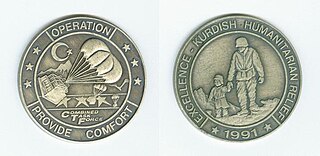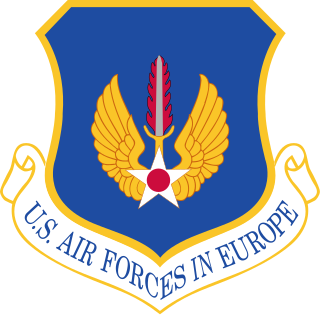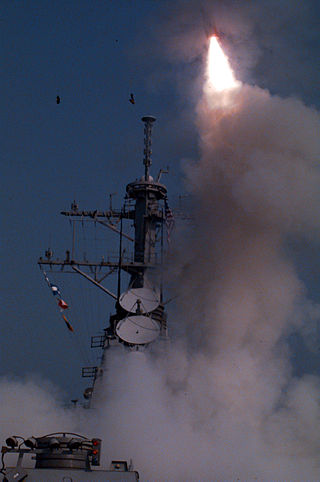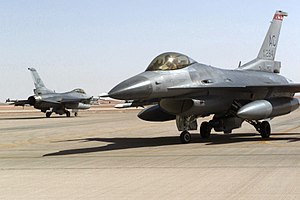
The Iraqi no-fly zones conflict was a low-level conflict in the two no-fly zones (NFZs) in Iraq that were proclaimed by the United States, United Kingdom, and France after the Gulf War of 1991. The United States stated that the NFZs were intended to protect the ethnic Kurdish minority in northern Iraq and Shiite Muslims in the south. Iraqi aircraft were forbidden from flying inside the zones. The policy was enforced by the United States and the United Kingdom until 2003, when it was rendered obsolete by the 2003 invasion of Iraq. French aircraft patrols also participated until France withdrew in 1996.

Operation Provide Comfort and Provide Comfort II were military operations initiated by the United States and other Coalition nations of the Persian Gulf War, starting in April 1991, to defend Kurdish refugees fleeing their homes in northern Iraq in the aftermath of the Gulf War, and to deliver humanitarian aid to them. The no-fly zone instituted to help bring this about would become one of the main factors allowing the development of the autonomous Kurdistan Region.

The McDonnell DouglasF-15E Strike Eagle is an American all-weather multirole strike fighter derived from the McDonnell Douglas F-15 Eagle. The F-15E was designed in the 1980s for long-range, high-speed interdiction without relying on escort or electronic-warfare aircraft. United States Air Force (USAF) F-15E Strike Eagles can be generally distinguished from other US Eagle variants by darker aircraft camouflage, conformal fuel tanks (CFTs) mounted along the engine intake ramps and a tandem-seat cockpit.
This is a list of aviation-related events from 1991.
Operation Southern Focus was a period in the months leading up to the 2003 invasion of Iraq in which the military responses to violations of the southern Iraqi no-fly zones were increased, with more intensive bombing of air defense artillery installations and other military complexes. It also marked a period of increased intelligence gathering. The operation lasted from June 2002 until the beginning of the invasion in March 2003. It was intended to be a "softening up" period prior to invasion, degrading Iraq's air defense and communication abilities. Lieutenant General T. Michael Moseley revealed the operation's existence in mid-2003.

The United States Air Forces in Europe – Air Forces Africa (USAFE-AFAFRICA) is a United States Air Force (USAF) major command (MAJCOM) and a component command of both United States European Command (USEUCOM) and United States Africa Command (USAFRICOM). As part of its mission, USAFE-AFAFRICA commands U.S. Air Force units pledged to NATO, maintaining combat-ready wings based from the United Kingdom to Turkey. USAFE-AFAFRICA plans, conducts, controls, coordinates and supports air and space operations in Europe, parts of Asia and all of Africa with the exception of Egypt to achieve U.S. national and NATO objectives based on taskings by the two combatant commanders.

Tactical Air Command (TAC) is an inactive United States Air Force organization. It was a Major Command of the United States Air Force, established on 21 March 1946 and headquartered at Langley Air Force Base, Virginia. It was inactivated on 1 June 1992 and its personnel and equipment absorbed by Air Combat Command (ACC).

The 1996 cruise missile strikes on Iraq, codenamed Operation Desert Strike, were joint United States Navy–United States Air Force strikes conducted on 3 September against air defense targets in southern Iraq, in response to an Iraqi offensive in the Kurdish Civil War.

Prince Sultan Air Base (PSAB) is a military air base located in the closed-city of Al Kharj, Saudi Arabia.

Operation Northern Watch (ONW), the successor to Operation Provide Comfort, was a Combined Task Force (CTF) charged with enforcing its own no-fly zone above the 36th parallel in Iraq. Its mission began on 1 January 1997.

The 161st Air Refueling Wing is a unit of the Arizona Air National Guard, stationed at Goldwater Air National Guard Base, Phoenix Sky Harbor International Airport, Arizona. If activated to federal service, the Wing is gained by the United States Air Force Air Mobility Command.

The 124th Fighter Wing is a unit of the Idaho Air National Guard, stationed at Gowen Field Air National Guard Base, Boise, Idaho. It operates the Fairchild Republic A-10 Thunderbolt II aircraft conducting close air support missions. If activated to federal service, the Wing is gained by the United States Air Force Air Combat Command.

The 33rd Fighter Wing, sometimes written 33d Fighter Wing, is a United States Air Force unit assigned to Air Education and Training Command's Nineteenth Air Force. It is stationed at Eglin Air Force Base, Florida where it is a tenant unit.

On 29 November 1990, the adoption of United Nations Security Council Resolution 678 authorized the assembly of a multinational military coalition to fight against Iraq in the Gulf War. The coalition's purpose was to liberate Iraqi-occupied Kuwait by "all necessary means" if Iraq did not withdraw by 15 January 1991. Iraq failed to relinquish control over Kuwait by the deadline specified in Resolution 678, leading to the commencement of combat operations with the Gulf War aerial bombardment campaign on 17 January 1991. At this time, the coalition consisted of 42 countries and was spearheaded by the United States: the central command was led by the United States, Saudi Arabia, and the United Kingdom; the marine command was led by the United States; the Joint Forces East Command was led by Egypt, Saudi Arabia, Syria, Morocco, Kuwait, Oman, the United Arab Emirates, Qatar, Bahrain, Poland, and Czechoslovakia; and the Joint Forces North Command was led by the United States, the United Kingdom, France, Canada, Italy, Australia, Japan, and Turkey. On 23 February 1991, the aerial bombardment campaign came to an end as the coalition began a large-scale ground offensive into Iraqi-occupied Kuwait and parts of Iraq. The Iraqi military was devastated in the fighting, and Kuwait was declared completely free of occupying Iraqi troops on 28 February 1991.

The 169th Fighter Wing is a unit of the South Carolina Air National Guard, stationed at McEntire Joint National Guard Base, Columbia, South Carolina. If activated to federal service, the Wing is gained by the United States Air Force Air Combat Command.

The 363rd Intelligence, Surveillance and Reconnaissance Wing is a United States Air Force unit. The group is assigned to the United States Air Force Sixteenth Air Force, stationed at Joint Base Langley-Eustis, Virginia.

The Gulf War of 1990–1991 included an air campaign, as the air forces of the coalition carried out an extensive aerial bombing campaign from 17 January 1991 to 23 February 1991 against Iraq. Spearheaded by the United States, the coalition flew over 100,000 sorties, dropping 88,500 tons of bombs, widely destroying military and civilian infrastructure. The air campaign was commanded by United States Air Force (USAF) lieutenant general Chuck Horner, who briefly served as Commander-in-Chief—Forward of U.S. Central Command while general Norman Schwarzkopf was still in the United States. The British air commanders were Air Vice-Marshal Andrew Wilson and Air Vice-Marshal Bill Wratten. The air campaign had largely finished by 23 February 1991 when the coalition invasion of Kuwait took place.
The General Dynamics F-16 Fighting Falcon has served the United States and the air arms of 25 other nations. Over 4,400 F-16s have been sold.
During the 1991 Gulf War and subsequent operations in no-fly zones over Iraq, Coalition air forces faced the Iraqi Air Force (IQAF), the fourth largest air force in the world at the time. In the opening days of the war, many air-to-air engagements occurred, between Iraqi interceptors and a variety of different Coalition aircraft.
Operation Samurra was an operation by the Iraqi Air Force (IQAF) during the Gulf War to decisively engage McDonnell Douglas F-15C Eagle fighters from the United States Air Force (USAF) using Mikoyan-Gurevich MiG-25 interceptors, and break the "wall" of F-15s that the Coalition had established along Iraq's border with Iran. It demonstrated the last true offensive operation of the IQAF before grounding their air assets in an attempt to preserve them for future use. Through careful planning and coordination, two MiG-25 jets successfully caught two USAF F-15 fighters, of the 53rd Tactical Fighter Squadron out of Al Kharj Air Base, off guard and engaged them in a dogfight. After several minutes of aerial maneuvering and several fired missiles, the Iraqi jets returned to Tammuz Air Base undamaged, and the F-15s returned to Saudi Arabia, albeit with one damaged.
















